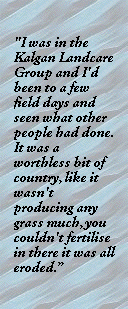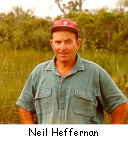
The Heffernan property, 'Bendy Creek', is located between the Stirling Range and Porongorup National Parks, about 50 kilometres north of Albany. Farm development in the area began in 1945 and the property was one of the last to be allocated in 1966. Neil took over the farm in 1973.
The Gaalgegup Creek runs through the property for 15 kilometres and is a major tributary of the Kalgan River, which eventually runs into Oyster Harbour to the south. The original riparian vegetation included paperbark (Melaleuca species), yate (Eucalyptus occidentalis) and native pine (Callitris species). Most of the riparian vegetation had been cleared when Neil took over the farm. The creek comprises a broad floodplain one kilometre wide with a braided channel 30 metres wide. It is still relatively fresh and in 1999 supported freshwater crustaceans and long-necked tortoises. Neil also uses the water for his stock and they drink directly out of it. The creek has two tributaries, Midyegillup Creek and Tingelup Gully, both of which have large catchments that include part of the northern slopes of the Porongorup Range. A further 11 kilometres of fencing is needed to complete the protection of the entire length of the Gaalgegup Creek.
The Problem
Neil describes the floodplain area as being "like an inland sea when it floods". He believes that there is more water that comes down the creek when it's in flood than the Kalgan River. The creek floods eight to ten times each year and Neil has seen the whole floodplain under almost a metre of water for a width of one kilometre.
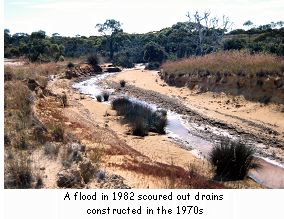 During the 1970s a series of drains measuring one metre wide and 0.5 metres deep were constructed to reduce waterlogging of the broad flats during winter. These drains worked efficiently for about ten years until a major rain event in summer 1982 when 150 millimetres of rain fell over a period of two days. This resulted in a flow which scoured the drains and caused metre deep channels down to bedrock across the floodplain. These channels then acted as the main drainage line for the creek flow and now the old channel only flows during winter. At the same time there was erosion of a firebreak that had been put in close to the creek, fences were washed away and roads were damaged.
During the 1970s a series of drains measuring one metre wide and 0.5 metres deep were constructed to reduce waterlogging of the broad flats during winter. These drains worked efficiently for about ten years until a major rain event in summer 1982 when 150 millimetres of rain fell over a period of two days. This resulted in a flow which scoured the drains and caused metre deep channels down to bedrock across the floodplain. These channels then acted as the main drainage line for the creek flow and now the old channel only flows during winter. At the same time there was erosion of a firebreak that had been put in close to the creek, fences were washed away and roads were damaged.
One of Neil's neighbours, who has been living there since 1945, had never seen the water come over the bridge on Washpool Road until the flood in January 1982. Neil believes it is more of the catchment being cleared in the 1970s that caused the higher runoff.
When asked why he began the landcare work Neil said, "I was in the Kalgan Landcare Group and I'd been to a few field days and seen what other people had done. It was a worthless bit of country, like it wasn't producing any grass much, you couldn't fertilise in there it was all eroded. It was a bit of a death trap for sheep too if a flood came down".
The floodplain also caused problems in summer in that "it was just bare brown soil, I used to run sheep in there of course and they used to pick on anything that had germinated".
The Solution
Restoration works have been carried out on the property along the whole channel and much of the floodplain of the creek. After the 1982 flood Neil put rocks and boulders at the point where the water diverted from the main channel in an attempt to halt the creek flow into the new channels. Unfortunately the following winter flood pushed most of the rocks downstream and the water continues to flow down the new channels.
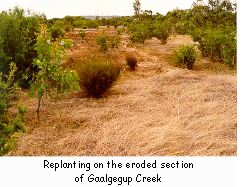 The whole length of the creek is now fenced off on both sides as Neil believes that, "Fencing out stock is the most important part of this landcare work". Some of the fencing was completed at Neil's expense and some was funded through the National Landcare Program (NLP) and Albany Waterways Management Authority (AWMA) as part of the Upper Kalgan Revegetation Project in 1994/95. Neil received a subsidy of $600 per kilometre to erect 2.2 kilometres of fence and all the seedlings were supplied and planted as part of the project. The planting program was carried out by Green Skills, who ripped and mounded the soil and sprayed for weeds prior to planting.
The whole length of the creek is now fenced off on both sides as Neil believes that, "Fencing out stock is the most important part of this landcare work". Some of the fencing was completed at Neil's expense and some was funded through the National Landcare Program (NLP) and Albany Waterways Management Authority (AWMA) as part of the Upper Kalgan Revegetation Project in 1994/95. Neil received a subsidy of $600 per kilometre to erect 2.2 kilometres of fence and all the seedlings were supplied and planted as part of the project. The planting program was carried out by Green Skills, who ripped and mounded the soil and sprayed for weeds prior to planting.
Neil was concerned that the mounds may be affected by the sheet water flow over the site during winter. To minimise this rows were ripped in a herringbone style pointing away from the direction of flow. This diverted and dissipated the floodwaters and thus reduced the potential for further erosion. The rows were placed ten metres apart and trees were planted at two metre spacings.
A large section of floodplain was fenced in 1990 and this section now comprises healthy floodplain vegetation and is too dense to walk through. Neil also fenced a further area of the floodplain and planted it with saltbush and Acacia cyclops for summer/autumn stock feed. Both areas have now been converted from bare scald to stable and useable land.
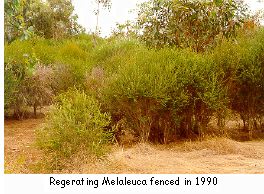
Neil has experienced problems with rabbits eating the seedlings and Green Skills put rabbit guards on the trees after planting. Poisoned 1080 baits were laid in late April, which killed most of the rabbits. Myxomatosis also affects the rabbits each year and Neil has not had any problems since 1995. Grazing by kangaroos has not been a problem during the revegetation.
The Outcomes and Observations
The part of the Gaalgegup Creek on the Heffernan's property is now completely fenced and regeneration of the native vegetation is occurring naturally. Neil is very enthusiastic about the natural regrowth and plantings and reports a 95% survival of planted trees. He is looking forward to it becoming very dense in a few years. The paperbarks have responded well to the exclusion of stock and they are regrowing even in areas of rock with very little topsoil. Neil noticed that the paperbarks came up within 12 months of fencing. He has also noticed that the native rushes and sedges are regenerating well. "It makes you feel good, because if you have a success you're willing to keep on trying. That's why I try to get other people on the creek to fence all theirs off. Partly to save mine and because this is so successful, but people haven't got the money".
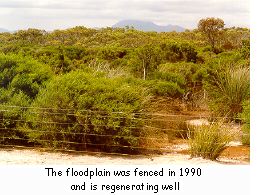 When talking about fencing off the floodplain patch of bush Neil says, "If I hadn't have done it I think this would have got worse, it just would have been a bare degraded area. There was plenty of money in 1988 when wool prices were good. By the time I got around to wanting to fence the creek things were getting worse and I wouldn't have done it without the $600 per kilometre. The grants have helped. I definitely wouldn't do it now because wool's not economic to grow. [I've] still got a couple of thousand sheep but [do] more cropping now".
When talking about fencing off the floodplain patch of bush Neil says, "If I hadn't have done it I think this would have got worse, it just would have been a bare degraded area. There was plenty of money in 1988 when wool prices were good. By the time I got around to wanting to fence the creek things were getting worse and I wouldn't have done it without the $600 per kilometre. The grants have helped. I definitely wouldn't do it now because wool's not economic to grow. [I've] still got a couple of thousand sheep but [do] more cropping now".
From a farm management perspective Neil says the landcare work has been "Good for me, good for the creek. It stops my sheep getting in the creek and getting drowned if we do get a flash flood. It makes it like a laneway to bring sheep home. So it hasn't cost me".
Gaalgegup Creek Catchment Statistics
| Type of stream: | Intermittent creek with ephemeral pools | |
| Annual rainfall: | 450-500 mm./year | |
| Water quality: | Fresh to marginal | |
| Catchment disturbances: | Stock grazing, cropping, vineyards |
